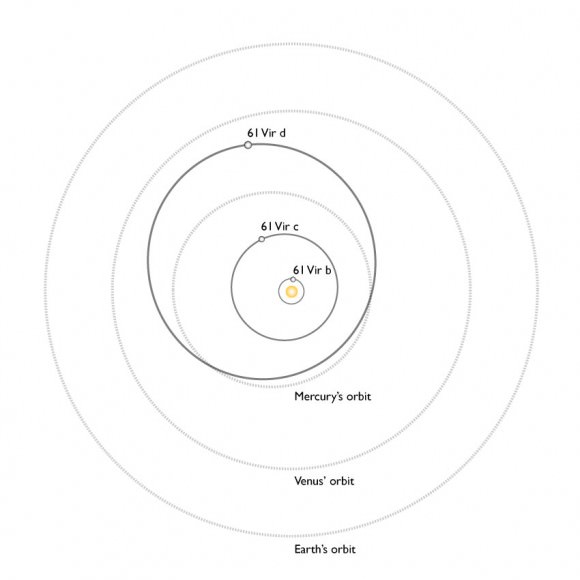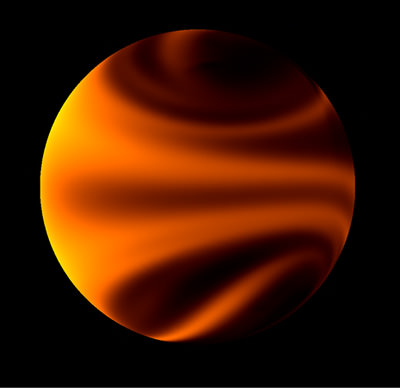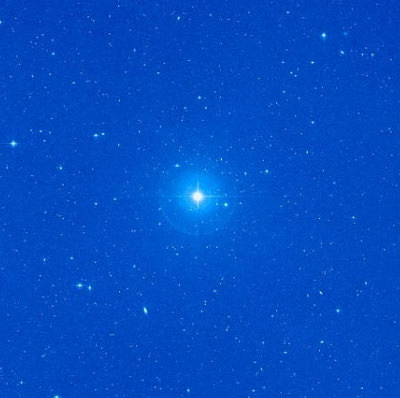Astronomers say it’s a “neck-and-neck race” as to whether the first potentially habitable planets will be detected from the ground or from space, and today an international team of planet hunters announced they have discovered as many as six low-mass planets around two nearby Sun-like stars, using two ground-based observatories. This haul of planets includes two “super-Earths” with masses 5 and 7.5 times the mass of Earth.
The researchers, led by Steven Vogt of the University of California, Santa Cruz, and Paul Butler of the Carnegie Institution of Washington, said the two “super-Earths” are the first ones found around Sun-like stars. These planets have orbits close to their stars and so they would be too hot to support life or liquid water.
“These detections indicate that low-mass planets are quite common around nearby stars. The discovery of potentially habitable nearby worlds may be just a few years away,” said Vogt, a professor of astronomy and astrophysics at UCSC.
The team found the new planet systems by combining data gathered at the W. M. Keck Observatory in Hawaii and the Anglo-Australian Telescope (AAT) in New South Wales, Australia.

Three of the new planets orbit the bright star 61 Virginis, which can be seen with the naked eye under dark skies in the Spring constellation Virgo. Astronomers and astrobiologists have long been fascinated with this particular star, which is only 28 light-years away. Among hundreds of our nearest stellar neighbors, 61 Vir stands out as being the most nearly similar to the Sun in terms of age, mass, and other essential properties. Vogt and his collaborators have found that 61 Vir hosts at least three planets, with masses ranging from about 5 to 25 times the mass of Earth.
Click here to see an animation showing a simulation of the hot atmosphere of the 5.3 Earth-mass planet 61 Vir b as it circles around its star in a 4.2 day orbit. The imaginary observer sits in space above the planet, and sees the hot side (which always faces the star) rotate into and out of view.
Recently, a separate team of astronomers used NASA’s Spitzer Space Telescope to discover that 61 Vir also contains a thick ring of dust at a distance roughly twice as far from 61 Vir as Pluto is from our Sun. The dust is apparently created by collisions of comet-like bodies in the cold outer reaches of the system.
“Spitzer’s detection of cold dust orbiting 61 Vir indicates that there’s a real kinship between the Sun and 61 Vir,” said Eugenio Rivera, a postdoctoral researcher at UCSC. Rivera computed an extensive set of numerical simulations to find that a habitable Earth-like world could easily exist in the as-yet unexplored region between the newly discovered planets and the outer dust disk.

The second new system found by the team features a 7.5-Earth-mass planet orbiting HD 1461, another near-perfect twin of the Sun located 76 light-years away. At least one and possibly two additional planets also orbit the star. Lying in the constellation Cetus, HD 1461 can be seen with the naked eye in the early evening under good dark-sky conditions.
The 7.5-Earth-mass planet, assigned the name HD 1461b, has a mass nearly midway between the masses of Earth and Uranus. The researchers said they cannot tell yet if HD 1461b is a scaled-up version of Earth, composed largely of rock and iron, or whether, like Uranus and Neptune, it is composed mostly of water.
According to Butler, the new detections required state-of-the-art instruments and detection techniques. “The inner planet of the 61 Vir system is among the two or three lowest-amplitude planetary signals that have been identified with confidence,” he said. “We’ve found there is a tremendous advantage to be gained from combining data from the AAT and Keck telescopes, two world-class observatories, and it’s clear that we’ll have an excellent shot at identifying potentially habitable planets around the very nearest stars within just a few years.”
The 61 Vir and HD 1461 detections add to a slew of recent discoveries that have upended conventional thinking regarding planet detection. In the past year, it has become evident that planets orbiting the Sun’s nearest neighbors are extremely common. According to Butler, current indications are that fully one-half of nearby stars have a detectable planet with mass equal to or less than Neptune’s.
The Lick-Carnegie Exoplanet Survey Team led by Vogt and Butler uses radial velocity measurements from ground-based telescopes to detect the “wobble” induced in a star by the gravitational tug of an orbiting planet. The radial-velocity observations were complemented with precise brightness measurements acquired with robotic telescopes in Arizona by Gregory Henry of Tennessee State University.
“We don’t see any brightness variability in either star,” said Henry. “This assures us that the wobbles really are due to planets and not changing patterns of dark spots on the stars.”
Due to improvements in equipment and observing techniques, these ground-based methods are now capable of finding Earth-mass objects around nearby stars, according to team member Gregory Laughlin, professor of astronomy and astrophysics at UCSC.
“It’s come down to a neck-and-neck race as to whether the first potentially habitable planets will be detected from the ground or from space,” Laughlin said. “A few years ago, I’d have put my money on space-based detection methods, but now it really appears to be a toss-up. What is truly exciting about the current ground-based radial velocity detection method is that it is capable of locating the very closest potentially habitable planets.”
Lead image caption: 61 Virginis is one of only a handful of truly Sun-like stars that can be seen with the naked eye. Astronomers have discovered three low-mass planets orbiting the star. Credit: NASA’s Sky View
Papers:
A Super-Earth and two Neptunes Orbiting the Nearby Sun-like star 61 Virginis
A Super-Earth Orbiting the Nearby Sun-like Star HD 1461
A long-period planet orbiting a nearby Sun-like star
Source: UC Santa Cruz


Another great find, it’s only a matter of time until we find one just like ours.
One thing I’ve always wondered when hearing about newly-discovered exo-planets is how gravity would affect the development of life. Obviously, right now we can only find the big ones, which begs the question, how big is too big? Is there a point where gravity would be too strong to keep proteins from forming, or to keep single-celled organisms from branching out into multi-cellular life?
It is possible to have life on a planet with the mass of Jupiter. Molecules are amzingly strong for there size. The difference is that on such a massive planet life would not evolve into anything very big, unless it is bouyed up by water. On these superEarths it is though possible for insect sized terrestrial life and low growing plant-like life forms.
LC
@ Lawrence B Crowell,
In Cosmos: A Personal Voyage, Carl Sagan postulated the existence of balloon-like life forms (“floaters”) and winged hunters that “eat the floaters both for their organic molecules and for their store of pure hydrogen.”
Crowell: Microbial life would definitely not be adversely affected by higher gravity fields, since they are too small for the extra gravity to matter that much. Multicellular life on the other hand, if it did exist, would look a lot different on a high-gravity planet!
I remember this idea by Sagan. I found this little clip from it.
http://www.youtube.com/watch?v=uakLB7Eni2E
It would be curious if something like these really existed.
LC
“Nature is not obliged to follow our speculations.” I like how that statement adds more humility than simply stating “But this is all just speculation.”
It is likely for larger animals to live on a planet with 3 to 4 times our gravity, if they happen to be in water!
So a Super Earth with oceans is likely to support life
I don’t think gravity is a problem for life as such. AFAIU primitive looking bacteria have two membranes with a sturdy wall between and doesn’t need to regulate inner pressure too much, as they can sustain tens of atmospheres pressure differential. (IIRC ~ 40 atm.)
The problem is that highly organized multicellularity has only arisen in late eukaryotes, cells with a flexible cell membrane. But then it happened several times independently. Bacteria can at most organize “societies” and “biofilms” and loose collective behavior, even if they now as parasites in larger organisms sometimes simplify their walls to membranes as well. And they had a much longer time to try.
So maybe multicellularity depends on lesser pressures and stable low enough temperatures.
Another problem with high pressures in high mass planets could be if green house permitting carbon dioxide would liquefy. Then a prolonged period in the much narrower habitable zone would be iffy at a guess.
The old fallacy on life not being able to live in high pressure environments in what we believe to be crazy temperatures was beaten away quite a while ago… when we started finding life at the bottom of our own oceans, and in the middle of glaciers.
Find a source of energy (which we now know can come in many forms), water and food; seemingly life can find a foot hold.
I don’t think there is any problem with celluar life such as bacteria living in high gravity environments. However, get much larger and there will be problems. It takes a lot of energy to motivate and hold yourself up outside of water. Which means complexity.
Aodhhan:
Yeah, I know what you mean; I have trouble getting my ass out of bed in the bloody morning!
😀